Overview
Brussels, September 18, 2025 – Odoo, a platform providing a suite of business management applications, kicked off its annual event, Odoo Experience - Europe’s one of the biggest Tech & Business event. The new product version is unveiled alongside the past year’s achievements and upcoming projects. Powered by an open-source, modular architecture and a culture that prizes simplicity, autonomy, and continuous delivery, Odoo continues to evolve rapidly, reinforcing its reputation as one of the most dynamic ERP systems.
Community & Ecosystem
Odoo Experience is, above all, a community event. Odoo employees take on different roles, running much of the on-site setup and venue operations themselves. Exhibitors from across the ecosystem showcase their work, and thousands travel to Brussels for learning, inspiration and networking. Attendees include clients, partners, consultants, developers, business leaders, and community members from around the world. Talks, sessions, and live demos share real case studies and success stories across industries, delivering practical takeaways and showing how teams scale Odoo in practice.
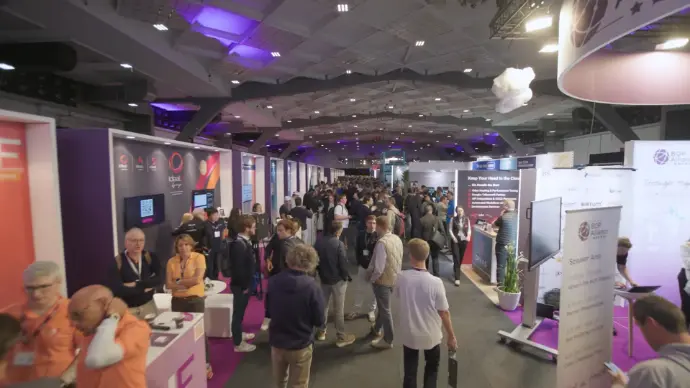
Stats at a glance
- 40k+ attendees from 150+ countries
- 400+ exhibitors, 400+ talks, 7 master classes (Agenda ↗)
- 175+ hours of talks (YouTube playlist ↗)
- ~150 startups participating (exhibitor/partner materials)
- ~60% C-level attendees (exhibitor/partner materials)
Keynote on Company Culture
Fabien Pinckaers, Odoo’s founder & CEO, delivered a first-time keynote on scaling that covered leadership, management, and culture—with lessons teams can apply to grow. The message was simple: improve every year, think long term, and keep progress the priority even if a year looks slower. That compounding mindset took Odoo from one person to a global team of 6,000+ and from about €10 million in early funding to a €7 billion valuation. Odoo leaned on culture to out-execute, with a lightweight approach—with a few exceptions where necessary: “no planning, no budget, no recurring meetings, no validation or decision process, no control, no OKR/KPIs”. The emphasis is on autonomy, simplicity, and continuous delivery over bureaucracy.
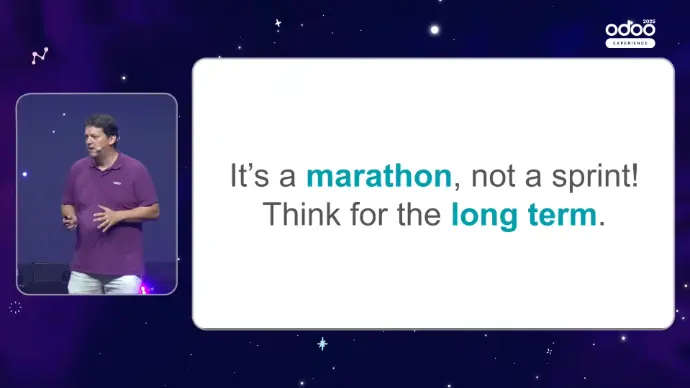
What stood out for us:
- Culture > Control
- Leadership > Management
- Learning > Limiting
CEO’s Role
As Odoo scaled, the CEO’s work increasingly resembled that of an Explanatory Officer. The focus shifts away from the individual leader and toward sustaining a culture owned by leaders across the organization. Alignment became the priority, anchoring teams in three motivators: autonomy, responsibility, and evolution.
That alignment also shaped how his time was spent: attention stayed inside the company rather than on external appearances: after-work parties, social clubs, conference circuits, or client lunches. For him, improvement comes from working on the core business.
When times get difficult, openness about it keeps the teams together. Managers and directors may be tempted to say everything is fine, but people notice—and when they do, trust is gone.
Team Leaders, Not Managers
Odoo grows leaders from within, avoiding external director hires. Promotions go to the best performers — people who excel at the work and have the drive to elevate and teach others. The core criterion is usefulness to the team — neither seniority nor an ambition to “manage people.” Ego is treated as a barrier to collaboration and a threat to team spirit.
The distinction between a team leader and a manager is fundamental. The company minimizes traditional management structures, avoiding recurring meetings, KPIs, processes, or budget-control cycles that slow people down. A team leader’s only goal is to make the team more efficient. They remove the burden of management so people can focus on the work. Team leaders lead by example and collaboration. The relationship inverts the traditional hierarchy: leaders serve the team, not the other way around.
Common Sense Over KPIs
How is “more efficient” measured? By proximity and common sense. Team leaders work closely with people and see effectiveness in day-to-day work, so extra KPIs aren’t needed when performance is plainly visible. Common sense from proximity beats proxy metrics: spend more time with customers and their work, rather than with spreadsheets or dashboards. KPIs matter only when they’re actionable. Otherwise, KPI-driven management drifts into irrelevance. Because measurement has a cost, tracking is kept to the minimum needed for decisions.
Micro-Reviews Over Macromanagement
Team leaders don’t try to oversee everything. Traditional managers often aim to know it all—and when an issue arises, they can’t solve it because they don’t understand the details. Leaders do the opposite: they go where they’re needed most, dig deep, uncover bottlenecks, and fix what impacts the company. Meanwhile, they leave the rest to the team they trust. It’s constructive involvement, not control.
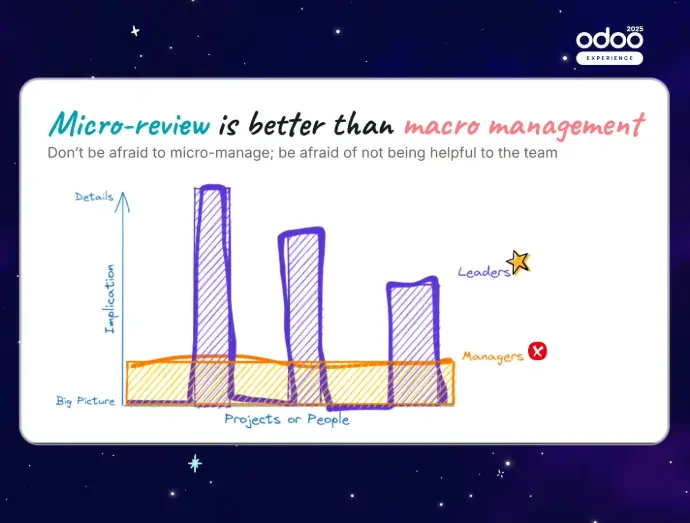
Responsibility Over Budgets
Odoo doesn’t rely heavily on fixed budgets. Assigning a budget often encourages spending rather than rational thinking. Without pre-allocated amounts, team leaders are taught to decide what’s truly worth the expense. This builds responsibility instead of compliance—and avoids the administrative overhead of constant budget approvals. In many cases, a control process costs more than the waste it tries to prevent.
Simplicity
Odoo’s growth reflects a simple idea: keeping things simple helps teams move faster. The company works to avoid the bureaucracy that often comes with scale. Instead of adding processes, Odoo removes them. Focus is defined not only by what to do, but especially by what not to do—keeping the organization agile, responsive, and clear on priorities.
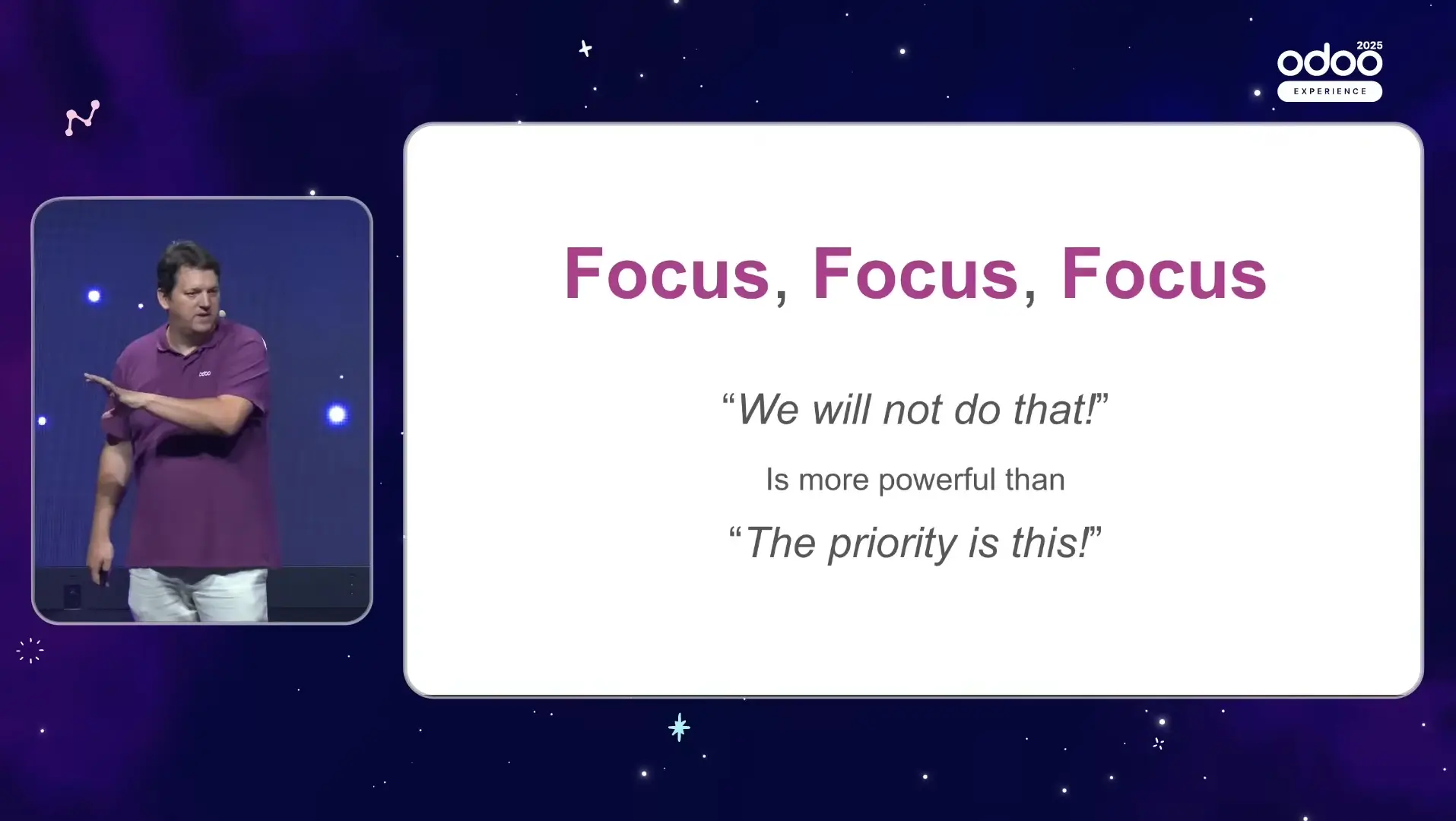
Because growth naturally introduces complexity, leaders fight that tendency—preserving autonomy and clarity as the company expands.
Odoo 19
This year’s release stands out for three reasons:
- More industry packages — about 100 curated setups (apps, roles, workflows)
- Three new apps:
- AI — embedded across modules and built into daily workflows (drafts, summaries, next-steps suggestions)
- ESG — helps companies track sustainability reporting and align with upcoming EU requirements and other regulations
- Equity — brings ownership and shareholder management system
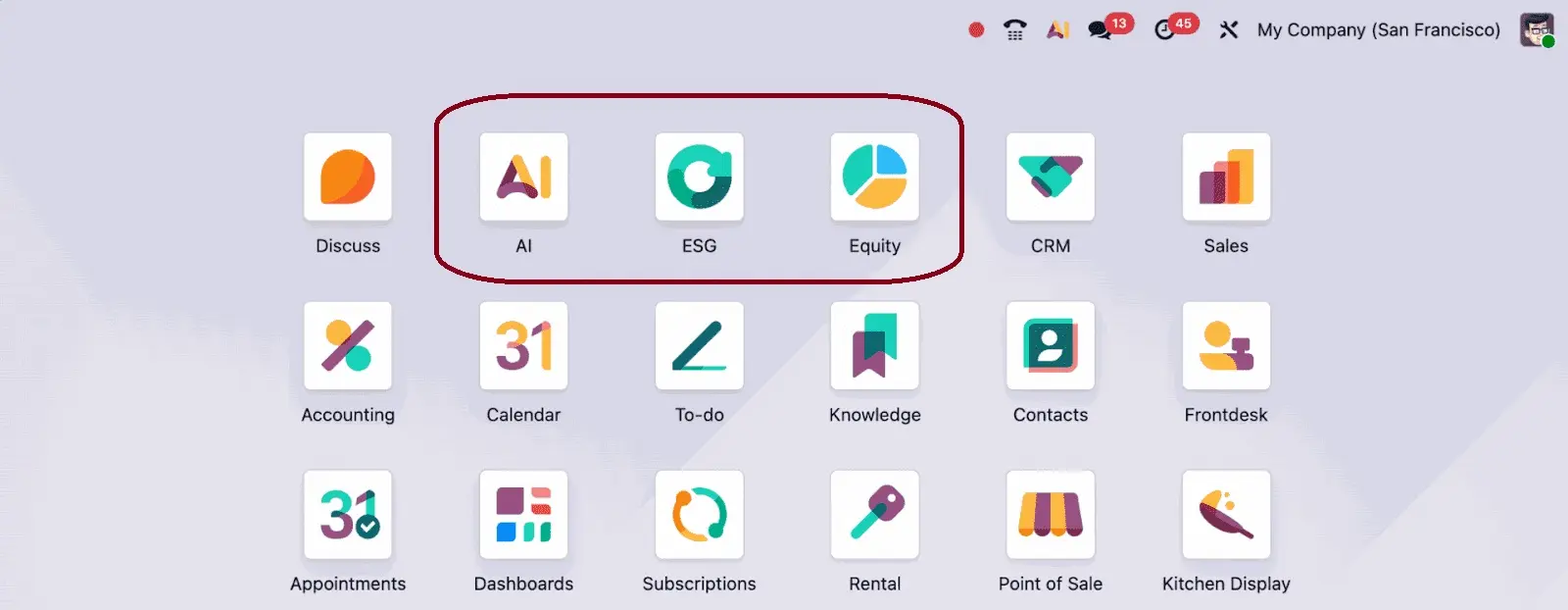
Taken together, these updates point in the same direction: Odoo is adding functionality for larger organizations and expanding AI-driven capabilities. They also improve UX and workflows with faster load times, a full offline mode, and more—making day-to-day work smoother for everyone.
Industries
This year’s industry focus scaled up significantly. Odoo expanded its curated industry packages from ~35 last year to ~100 now. These ready-made packages enable businesses to set up their systems in each sector with preconfigured apps, roles, and workflows. Improvements to existing packages were also highlighted, including those for accounting firms and HoReCa (hotels, restaurants, and cafés).
The Point of Sale package was deployed in nearly 200 HoReCa establishments to gather feedback and iterate. Restaurant owners now have a fully integrated solution—including a cash register system, mobile ordering, kitchen displays, and online reservations.
The fiduciary sector has also been a priority. Three of the world’s four largest audit and consulting firms (the Big Four) have adopted Odoo’s suite—a vote of confidence Odoo intends to honor by continually improving compliance, robustness, and capabilities.
With new European e-invoicing regulations, the Invoicing app has been a core focus: ensuring compliance while becoming more efficient and user-friendly. In 2025, Odoo Academy held weekly sessions in Wallonia and Flanders, training around 200 participants per week on administrative and financial features. In parallel, 21 business shows across Belgium raised awareness of Peppol for about 2,000 attendees. Altogether, several thousand people across Europe have been guided in using the Invoicing module and meeting the new legislative requirements.
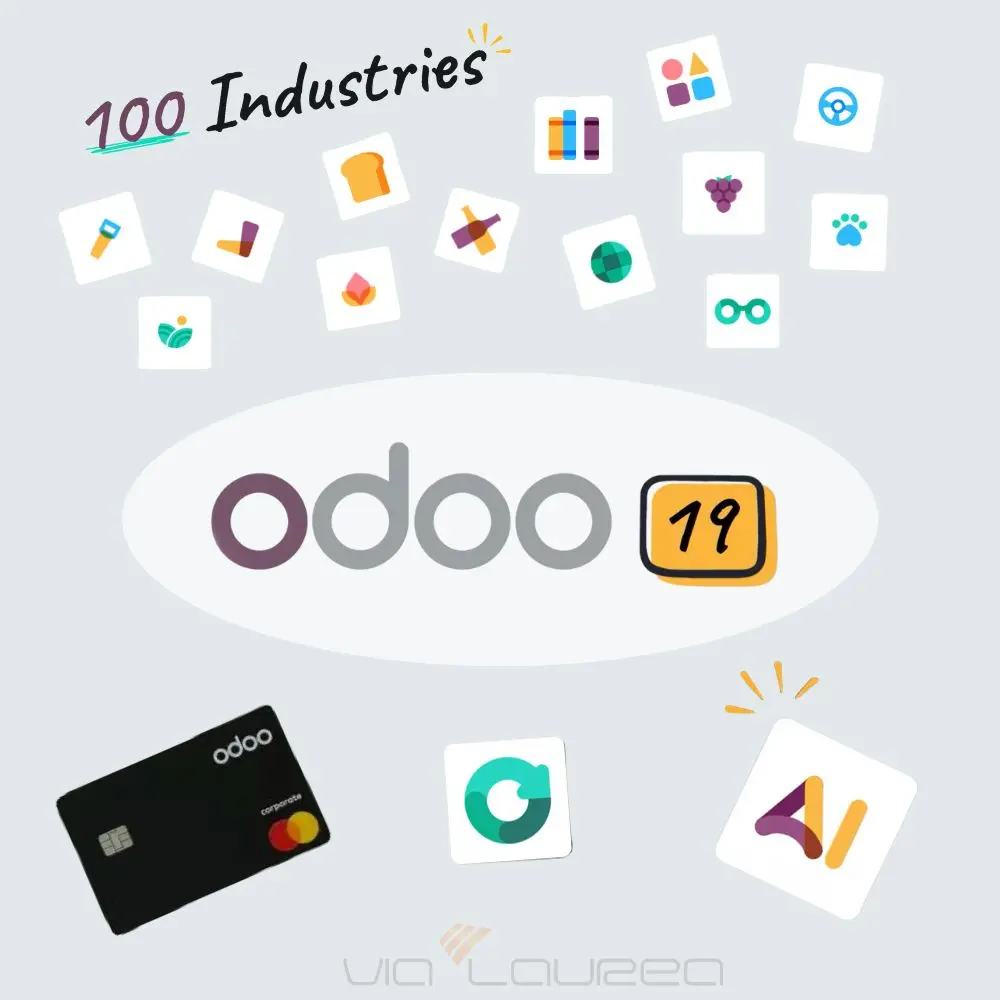
AI Integration
AI took center stage at Odoo Experience. With Odoo 19, a new AI app arrives alongside system-wide assistants embedded in core workflows. Demos and materials highlighted AI-assisted actions (document handling, suggestions, automation) and “ask + do” agents that can answer questions over your data and take actions inside Odoo.
Examples in Odoo 19:
- AI-powered fields that auto-fill, summarize, or categorize data
- Speech-to-text notes turned into structured, filterable records
-
Natural-language search that answers questions like: 'Which project cost us the most this quarter?'
- AI-generated dynamic reports that render charts instantly
- AI in communication & live chat — from AI-drafted, personalized emails (sales, recruiting) to real-time site chat that answers questions and creates leads
- Customizable AI agents across Odoo
- Website creation and rewriting with AI building blocks and automated SEO
The intent is clear: make AI part of everyday Odoo. From smarter accounting suggestions to faster data handling and cross-app automation—so day-to-day work becomes simpler and more automated across the suite.
For developers, this translates into easier customization and faster module development. Because much of Odoo’s open-source codebase, docs, and conventions are publicly available, modern language models have already “seen” Odoo in their training data—so they already understand the framework and common workflows without additional fine-tuning. Proprietary suites often need extra layers (like pulling in their private docs) to reach similar results. Simply put: AI loves open data — and Odoo has it.
Closing & Outlook
Odoo’s performance in 2025 and outlook for 2026
Alongside the launch of version 19, Odoo shared headline figures. In 2025, the Belgian company is expected to generate €650 million in revenue and 42% growth in annual recurring revenue (ARR). With a profitable, sustainable model, Odoo expects to reach the €1 billion mark by 2027. Headcount stands at ~7,000 and is planned to grow to 10,000 in 2026.
An ambitious path for 2026 and beyond
Looking ahead to 2026, Odoo has several large-scale projects in the pipeline and remains focused on its mission: to provide a leading management software with all the tools businesses need to streamline operations and improve results. As CEO Fabien Pinckaers put it: “What matters most to me is seeing customers satisfied with the product’s features.”